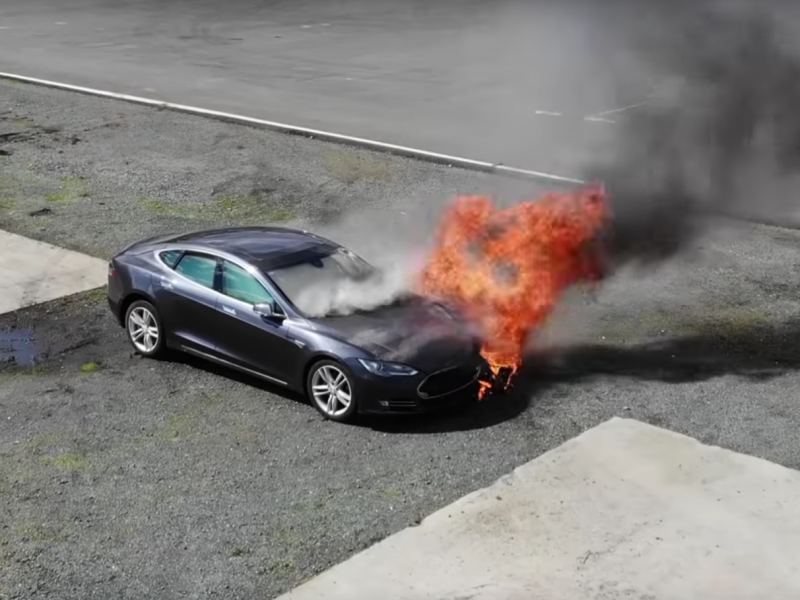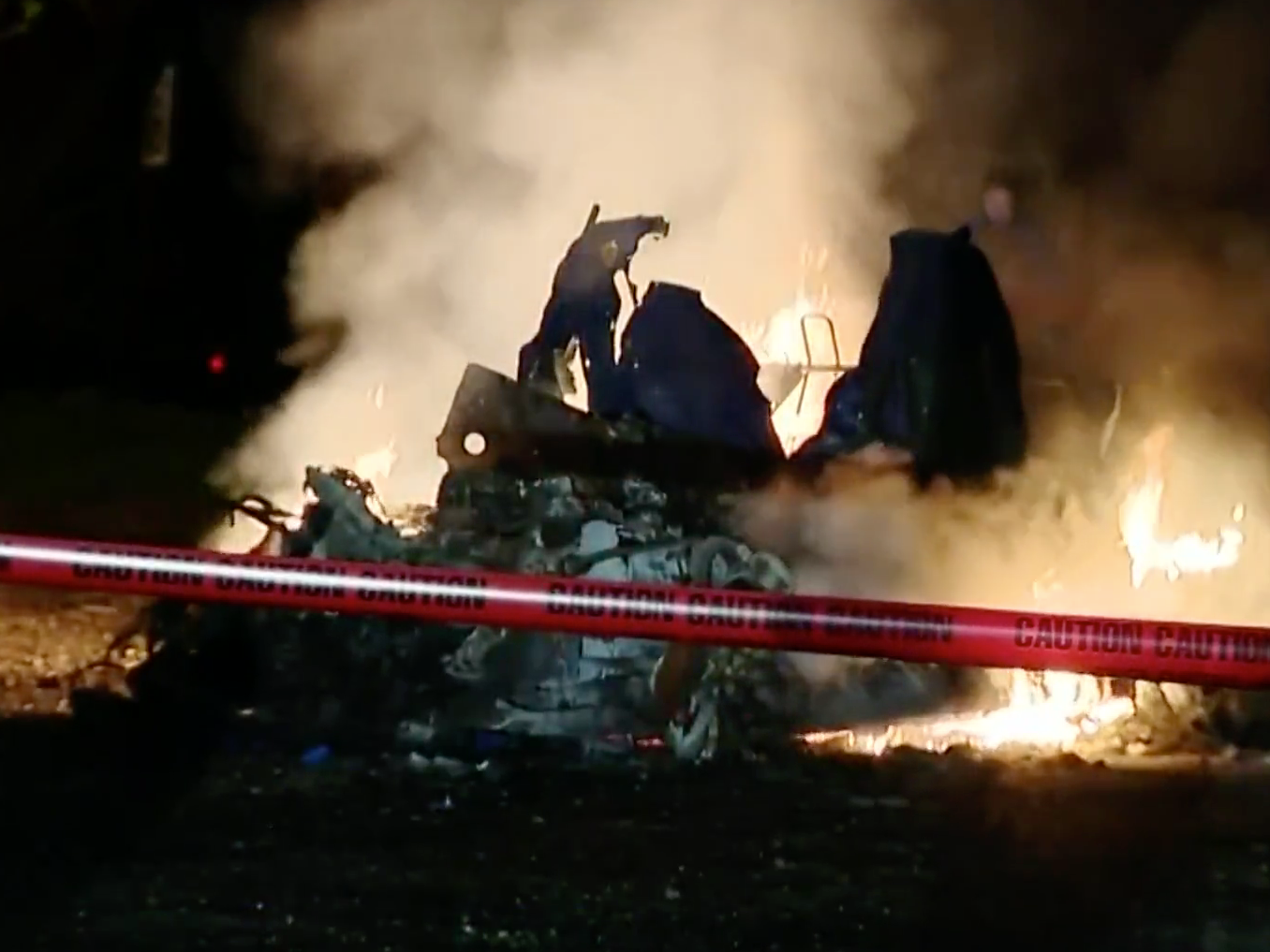- Tesla fires have become a battleground for the company’s supporters and detractors.
- Supporters say the media makes too much of Tesla fires. Detractors say Tesla isn’t being open enough about what causes them.
- Some fires start after a crash. But others – like a recent one that engulfed a Model S sitting in a parking lot in Shanghai – seem to have started for no reason at all.
- “There are really only a few reasons why a lithium-ion battery catches on fire,” one fire expert told Business Insider. “Liquid, dead short,” or, for every one battery cell in a billion, “spontaneous combustion.”
- Factors outside the battery, like a crash or other damage, matter. But manufacturing issues matter too.
There was yet another Tesla fire, this time in Shanghai.
It broke out as a Tesla Model S was sitting in a parking garage. The car had not just suffered an impact, as in previous fire cases, and it was not charging. Thankfully, no one was hurt. The company is investigating the incident.
In the world of Tesla, fires have become a battleground for the company’s supporters and detractors. Supporters accuse the media of making too much of the sometimes grisly incidents. They point out that combustion-engine fires happen all the time without garnering any attention.
Detractors accuse the company of not being open enough about the cause of the fires and why they sometimes occur even though a car has not appeared to have sustained any kind of impact.
Heated
The debate has gotten so intense that CEO Elon Musk has joined the fray, tweeting in hopes of dispelling any notions that electric vehicles are more dangerous than cars with internal combustion engines.
Reality is a Tesla, like most electric cars, is over 500% *less* likely to catch fire than combustion engine cars, which carry massive amounts of highly flammable fuel. Why is this never mentioned?
— Elon Musk (@elonmusk) April 23, 2019
Chris Brown of Aristides Capital, who tweets under the moniker @midwesthedgie and is short Tesla, responded to Musk by walking through the numbers using data from the National Fire Protection Association (where the most recent data available is from 2015).
Brown broke it down like this:
- From 2011 to 2015, 325 people in the US on average died each year in internal-combustion-engine vehicle fires.
- That's out of 263.6 million registered vehicles in the US.
- That means there were, on average, about 1.23 fire deaths per million vehicles annually from 2011 to 2015. Most of them, 58%, started with a vehicle collision or overturn.
- Tesla has yet to build 1 million total cars, but it has grown its fleet substantially in the past few years. In 2016 it had only 183,000 cars on the road. In February of last year it produced its 300,000th car.
- At the start of 2019, Tesla had about 530,000 cars on the road all over the world, the vast majority of those being in the US.
- "Thus, if Tesla were an average car, we would have expected 0.23 Tesla fire deaths in 2016, 0.35 in 2017, 0.45 deaths in 2018, and 0.16 deaths in 1Q 2019," Brown wrote. That's a total of 1.19 fire deaths over three years.
Tragically, that isn't what has been happening.
Last month, a Davie, Florida, man died after his Tesla crashed into a tree and ignited. First responders were reportedly not able to open the car's extendable door handles.
In December, a woman in New Hampshire died after her car ignited following a crash.
Last May, two teenagers in Fort Lauderdale, Florida, died after the one driving a Tesla Model S crashed into a wall and the battery caught fire.
Business Insider has counted at least 20 reported incidents of Teslas catching on fire since 2013 and five deaths in the past 14 months.
That is part of the reason these fires are getting so much attention. It's life, death, and math.
Tesla took issue with this calculation, saying the occupants of these cars would have died when their cars crashed regardless of whether the cars caught fire.
"The calculation cited by Business Insider is highly misleading because it implies that each of the cited fatalities were caused by fire-related injuries, whereas most traffic fatalities - even ones where a crash results in a fire - are due to impact-related injuries caused by the initial crash," a Tesla representative said.
"Based on the evidence, in every such case we know of involving a Tesla vehicle, the occupant would have died whether the crash resulted in a fire or not. This analysis is also flawed in that it compares our powerful performance vehicles to the buses, motorcycles, and trucks that are included in US vehicle registration data."
If you have any experience working with electric vehicle fires (Tesla's or any other car's) email me at [email protected].
How it burns
Most of these Tesla fires seem to be caused by the electric vehicle's battery suffering some kind of trauma, sometimes by crashing at high speeds. In the Davie incident, the driver was going between 75 mph and 90 mph on a road with a 50-mph speed limit. The two teens who died in Fort Lauderdale were going 116 mph.
"Whether it's Tesla fires, or BMW or Fisker, if you look at the ones that caught on fire, almost every single one of them was operating outside of agency testing parameters," the auto-extrication and fire-rescue expert Brock Archer told Business Insider over the phone. "They were going too fast and ended up crashing."
But there have been a few fires, like the one in Shanghai, in which the battery was not damaged. These fires are strange even to those who have focused on preparing for an electric-vehicle revolution.
"There are really only a few reasons why a lithium-ion battery catches on fire," Archer said. "Liquid, dead short," or, for every one battery cell in a billion, "spontaneous combustion."
Every Tesla battery is made up of thousands of cells, which are configured into the modules that make up a battery pack. So while one out of every billion cells sounds like a lot, consider that Tesla's Gigafactory aims to make 3 million cells a day, and Elon Musk thinks that's not enough. He wants more.
The arrival of lithium-ion batteries on the road is a unique challenge for rescue experts, who have ramped up efforts to teach first responders around the world the best practices for fighting lithium-ion-battery fires.
We should note here that Archer said across the whole auto industry, electric vehicles catch fire at slightly lower rates than cars with internal combustion engines - and hybrids do so at much lower rates, as their high-voltage batteries are smaller - and that he said fighting an electric vehicle fire was no more difficult than fighting an internal-combustion-engine fire for those who know what they're doing.
We should also note that he's worked closely with Tesla on firefighting in the past.
A damaged battery cell - whether the damage has been done by some kind of impact, water damage, or manufacturing defect - can go into "thermal runaway." That's when the temperature in the cell rapidly increases and then triggers the same reaction in another cell and another one after that. That is called "cellular propagation," and in some cases it manages to stop itself inside the battery.
In other cases, though, you've got a fire on your hands.
.@ElonMusk complained of “double standard” on Twitter after a @Tesla vehicle ignited on its own in Shanghai on April 21, saying that “over a million combustion engine car fires per year & thousands of deaths, but one Tesla car fire with no injuries gets biggest headlines.” pic.twitter.com/B9kgH5rSOS
— China Daily (@ChinaDaily) April 24, 2019
A different fire
According to training videos being disseminated among first responders, firefighters cannot put out a lithium-ion-battery fire with foam or dry chemicals. These fires cannot be fought with anything but 500 to 8,000 gallons of water and patience. Responders should expect a longer commitment time to the fight than they would in a combustion-engine fire, and they should be mindful that the fire could reignite days after it seemed to be under control.
That's what happened during another strange incident in Los Gatos, California, in December.
The owner of a 2018 Tesla Model S with about 1,200 miles on the odometer took the car to a repair shop after getting a flat tire on the highway. While the owner was inside the repair shop, around 2 p.m., the car suddenly ignited and firefighters were called. They used about 2,000 gallons of water to put the fire out.
While the owner was inside the repair shop, around 2 p.m., the car suddenly ignited and firefighters were called. They used about 2,000 gallons of water to put the fire out.
The car reignited at the shop at about 10 p.m.
(This is why experts say any electric vehicle that has experienced a battery fire should be kept 50 feet from any objects for a few days.)
A police report obtained by Business Insider could not determine the cause of the Los Gatos fire. Archer says the source of the fire is often so damaged that it's impossible to say what exactly caused a battery to go into thermal runaway - whether it was triggered by something outside the battery or a defect inside the battery.
To be fair, Tesla is not the only company that has dealt with stationary cars catching on fire. In 2017, BMW recalled a million cars with defective PCV valve heaters and blower motor system connectors after ABC did an investigation into mysterious fires starting in parked BMWs that would sometimes reignite days after being put out.
"At BMW, the safety of our customers is a top priority," a BMW spokesman, Hector Arellano-Belloc, said in a statement after the recall was announced. "We understand the serious nature of a vehicle fire, which is why we are taking appropriate steps to repair our customers' vehicles."

One in a billion
Archer stressed that a lot of outside factors could contribute to an electric-vehicle fire, such as damage to the battery or the car's state of charge. Most incidents, he said, occur when a car is fully charged or charging.
And since a single defective cell can trigger thermal runaway, manufacturing glitches matter too.
That is why, as Business Insider previously reported, an oil spill on the Panasonic operating side of Tesla's Gigafactory last September sent the factory scrambling. The spill was detected on September 17, according to internal documents viewed by Business Insider, but it's unclear exactly when it started. Mechanical oil got onto one of Panasonic's massive machines used to press battery chemicals into a sheet.
The machine then contaminated any product it touched. Employees had to stop what they were doing and sift through millions of nearly finished battery cells to find products that might've been affected, sources said. They searched for cells dating back to September 11.
Not all potentially damaging incidents are that dramatic, though. Sources also reported incidents of tools or scissors falling into the massive 16-foot-high mixers that churn lithium and other chemicals.
Greg Less, the technical director of the University of Michigan Energy Institute's Battery Fabrication and Characterization User Facility, told Business Insider that if a piece of shrapnel - something as small as a millimeter or half a millimeter - got into the lithium mix, the battery cell could cause a hard short or even a fire.
"That's horrifying," he said. "If you have something metal inside of your mixer and it's grinding around in your mixing jar, you're going to get shrapnel."
A Tesla representative said that the company conducted multiple tests on battery cells once they're received from Panasonic and that cells that didn't make the cut were sent back to Panasonic.
"Tesla vehicles achieved the lowest probability of injury of any vehicles ever tested by U.S. government [NCAP] safety rating program," Tesla said in a statement to Business Insider, "and based on our fleet of over 500,000 electric cars, we know that a Tesla vehicle is approximately 10 times less likely to experience a fire than a gas car."
If you have any experience working with Tesla or Panasonic, email me at [email protected].

